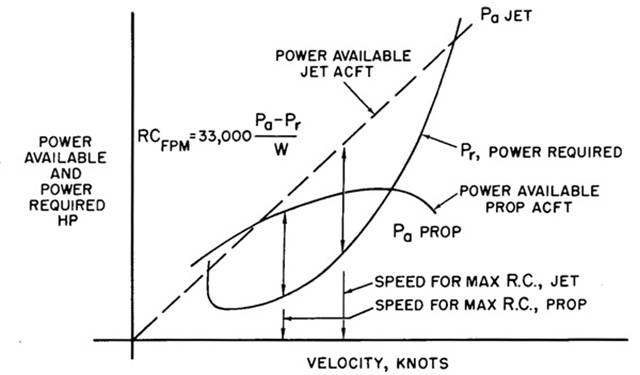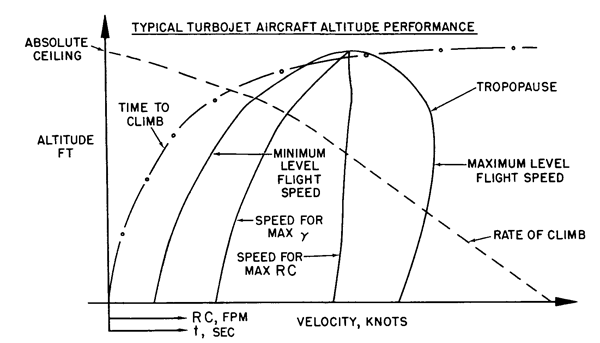Choosing climb speed to get from low to high as quickly as possible is a chore we face just about every flight. The answer varies with weight, temperature, and even with wind. Most aircraft manufacturers give us a single speed or a few speeds that change with altitude.
— James Albright

Updated:
2016-04-16

Jet aircraft obstacle clearance, from Dole, figure 3.21
Unfortunately there is no easier answer than flight test. After flying an aircraft for many years many of us get a "feel" for what is right and what is wrong for various conditions. When we leave the airplane that knowledge often leaves with us. Sometimes a "feel" is all we have. Most of my Gulfstream time is in the GV and G450, with less in the GIII and GIV. My conclusions?
- GIII — The published climb speed 0.75 Mach seems about right.
- GIV, G450 — The published climb speed 0.75 Mach can be improved on, about 0.77 seems about right.
- GV — The published climb speed 0.80 Mach is perfect.
What, no math? Yes, there is plenty of that, but the conclusion is pretty straight forward: your best rate of climb speed is faster than your best angle of climb speed.

2
What it really means
Force Analysis

Climb performance, from Air Training Command Manual 51-3, figure 2.21.
- When the airplane is in steady flight with moderate angle of climb, the vertical component of lift is very nearly the same as the actual lift. Such climbing flight would exist with the lift very nearly equal to the weight. The net thrust of the powerplant may be inclined relative to the flight path but this effect will be neglected for the sake of simplicity. Note that the weight of the aircraft is vertical but a component of weight will act along the flight path.
- If it is assumed that the aircraft is in a steady climb with essentially small inclination of the flight path, the summation of forces along the flight path resolves to the following:
where
T = thrust available, lbs.
D = drag, lbs.
W = weight, lbs.
γ ("gamma") = flight path inclination or angle of climb
Source: Air Training Command Manual 51-3, page 152
Of course some very high performance corporate aircraft, such as the G450, climb at angles where you cannot assume the inclination of the powerplant is negligible. Hence the section devoted to 1950's fighter type aircraft become suddenly applicable to us . . .
VY Best Rate of Climb Speed

Climb performance, power available and power required, from Air Training Command Manual 51-3, figure 2.21.
- The vertical velocity of an airplane depends on the flight speed and the inclination of the flight path. In fact, the rate of climb is the vertical component of the flight path velocity. By [the diagram], the following relationship is developed:
- The above relationship states that, for a given weight airplane, the rate of climb (RC) depends on the difference between the power available and the power required (Pa - Pr).
- One of the most important items of climb performance is the maximum rate of climb. By the previous equation for rate of climb, maximum rate would occur where there exists the greatest difference between power available and power required, i.e., maximum (Pa - Pr).
since
then
and,
and,
where:
RC = rate of climb, fpm
Pa = power available, h.p.
Pr = power required, h.p.
W = weight, lbs.
and
33000 is the factor converting horsepower to ft-lbs/min
Source: Air Training Command Manual 51-3, page 152

Typical turbojet aircraft altitude performance, from Air Training Command Manual 51-3, figure 2.22.
- The power curves for the representative jet aircraft show the near linear variation of power available with velocity. The maximum rate of climb for the typical jet airplane will occur at some speed much higher than for maximum rate of climb of the equivalent propeller powered airplane.
Source: Air Training Command Manual 51-3, page 152
Unlike Best Angle of Climb Speed (VX), there is no cut and dried way to find the best Rate of Climb Speed (VY) for a jet aircraft other than to flight test it. As pilots we are at the mercy of those who came before us. We learn from them by careful review of performance charts and, for the lack of a better term, folklore. GIV pilots, for example, have an intuitive understanding that the airplane climbs better a bit faster than the published climb speed of 0.75 Mach.
3
Gulfstream example
Gulfstream does not offer anything close to a VY chart, other than to recommend a best climb speed. The 0.80 M in a GV seems about right. The 0.75 M in a GIV or G450 seems a bit slow. We are left to study our aircraft in search of VY. . .
4
How to approximate your VY
By all means fly your aircraft's published climb speed. But you might consider a bit faster and a pad of paper. If you have a typical flight profile with the same takeoff weight and climb altitude, consider flying the published speed and keeping a log of the following:
- Starting weight, temperature, anti-ice status
- Every 5,000 feet record time from takeoff, altitude, temperature
Once you've compiled fairly consistent data start all over at 0.02 Mach faster. If your time to climb improves you know your published climb speed can be improved.
References
(Source material)
14 CFR 1, Title 14: Aeronautics and Space, Definitions and Abbreviations, Federal Aviation Administration, Department of Transportation
14 CFR 25, Title 14: Aeronautics and Space, Federal Aviation Administration, Department of Transportation
Air Training Command Manual 51-3, Aerodynamics for Pilots, 15 November 1963
Dole, Charles E., Flight Theory and Aerodynamics, 1981, John Wiley & Sons, Inc, New York, NY, 1981.
Gulfstream G450 Airplane Flight Manual, Revision 35, April 18, 2013.
Gulfstream G450 Aircraft Operating Manual, Revision 35, April 30, 2013.
Please note: Gulfstream Aerospace Corporation has no affiliation or connection whatsoever with this website, and Gulfstream does not review, endorse, or approve any of the content included on the site. As a result, Gulfstream is not responsible or liable for your use of any materials or information obtained from this site.